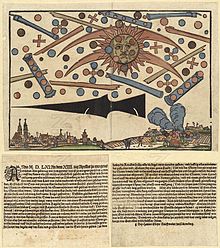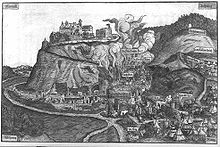Hans Glaser (wood cutter)
Hans Glaser († 1573 ) was a German wood cutter and book printer who worked in Nuremberg between 1538 and 1573 .
Life
Hans Glaser, also Hanns Glaser, Hans Glasser, Hans Glaßer or Hans Wolff Glaser was probably born shortly after 1500 and buried on June 2, 1573 in Nuremberg. He also referred to himself as a form cutter , letter painter and letter printer and is listed as such from 1538 in the office books of the city of Nuremberg. Until 1553 he lived in Nuremberg "uff den Schmelzhütten", after which Glaser had his workshop in the immediate vicinity of the parish church of St. Lorenz . Glaser was married, and after 1575 his widow married Wolf Drechsel, a former apprentice of her husband, who continued Glaser's workshop and continued to use his printing blocks.
Work and work
In his work, Glaser paid special attention to political and social events, which he described and sold in combined word and picture leaflets. He operated a kind of mailing system throughout the Holy Roman Empire . The subjects of his leaflets were warlike events, including, above all, sieges , historical meetings and conferences, astronomical phenomena and portraits of contemporary princes and celebrities. Already from 1540 Glaser seems to have turned strongly to the Protestant side, so he produced a leaflet in which he compared the teaching of Christ with the teachings and guidelines of the Pope. Glaser made numerous woodcuts of mercenaries and is considered an excellent source of equipment, clothing, armament and life of the mercenaries in the mid-16th century. His numerous battle and siege woodcuts between 1552 and 1554 earned him the title of letter painter of the Second Margrave War .

More recently, Glaser's report and a woodcut from the year 1566 have made a name for themselves about an astronomical phenomenon that had taken place five years earlier: it was "a vngewonlich face / on which the suns appear." April 1561 was said to have been seen by "many men and women" over the city of Nuremberg. Glaser shows balls of blood-red, bluish and black color, "Ringscheyben" around the sun as well as "several blood-colored Creutz". In view of the Reformation (introduced in Nuremberg 36 years earlier), the local population interpreted this as a divine warning not to fall away from true faith. Among ufologists Glaser image report as UFO interpreted -Landung or even as a witness report of a spaceship battle over Nuremberg. Rather, however, the two downward sloping cylindrical objects resemble the phenomenon of the sub-sun and the other lines resemble halo effects . Numerous simpler representations of such atmospheric reflections are known from the 16th and 17th centuries.
Glaser also observed changes on the moon's surface in 1561, which he recorded in another woodcut.
Glaser also produced heraldic books for noble and patrician families. His works can be found in many important museums, including the British Museum , the Germanisches Nationalmuseum Nürnberg, the Kupferstichkabinett Berlin , and the Boston Museum of Fine Arts .
Works
- An unusual face / on which the suns appear. Published “Bey Hans Glaser letter painter zu Nürmberg, behind S. Lorentzen on the square”, Nuremberg 1556, 1 illustrated sheet, woodcut 246 × 246 mm colored; Folio sheet 346 × 248 mm. Collection: Wikiana, ZB Zurich, Bibl.-No .: 14, Sig. Mscr.Dresd.L.83_Bl.139.
- A wonderful face of the moon / so yetz again the next day of March in this LXI. Jar / seen by many people in Nuremberg / warhaftig . Woodcut 268 × 262 mm colored; Folio sheet 403 × 320 mm. Collection: Wikiana, ZB Zurich, without sign.
- The castle Blassenburg, sampt the burned stat Kulmbach. Which Margrave Albrecht Kriegsvolck set himself on fire in the deduction, with all due cause , printed at Nuremberg 1554, Kulmbach City Archives.
literature
- Josef Benzing : Buchdruckerlexikon des 16. Century (German language area) , Frankfurt am Main 1952, p. 134 f.
- Sven Hauschke: Glaser, Hans . In: General Artist Lexicon . The visual artists of all times and peoples (AKL). Volume 56, Saur, Munich et al. 2007, ISBN 978-3-598-22796-7 , p. 28.
- Monika Heffels; Axel Janeck; Wolfgang Mössner et al .: Dürer's role model - copper engravings and woodcuts by Albrecht Dürer as reflected in European prints of the 16th century , catalog of the 1978 exhibition, Munich 1978.
- Walter S. Strauss (Ed.): The German Single-leaf Woodcut 1550-1600 . New York 1975, Vol. 1, pp. 340-362.
Web links
Individual evidence
- ^ * Robert W. Scribner, Lyndal Roper, Wolfgang Kaiser: Religion and Culture in Germany 1400–1800 (= publications of the Max Planck Institute for History, Volume 175). Göttingen 2002, p. 145.
- ↑ Hans Glasser: The Blassenburg Castle, sampt the burned stat Kulmbach. Which Margrave Albrecht Kriegsvolck set themselves on fire in the deduction, with all the odds . Nuremberg 1554, Kulmbach City Archives
- ↑ UFOs over Nuremberg: What was going on in our sky? Evening newspaper, local editorial office Nuremberg, December 22, 2008
- ↑ ufoevidence.org ( Memento of the original from December 3, 2013 in the Internet Archive ) Info: The archive link was inserted automatically and has not yet been checked. Please check the original and archive link according to the instructions and then remove this notice.
- ↑ meteoros.de
- ↑ “A wonderful face of the moonlight / so yetz new the next day of March in this LXI. Jar / seen by many people in Nuremberg / warhaffig ” . Woodcut 268 × 262 mm colored; Folio sheet 403x320 mm. Collection: Wikiana, ZB Zurich.
| personal data | |
|---|---|
| SURNAME | Glaser, Hans |
| BRIEF DESCRIPTION | German wood cutter and printer |
| DATE OF BIRTH | 16th Century |
| DATE OF DEATH | before June 2, 1573 |
